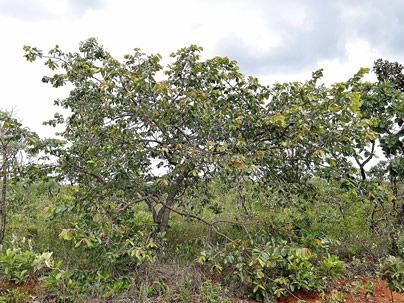The Mangaba (Hancornia speciosa) is the fruit of the mangabeira, a tree typical of the Brazilian caatinga and cerrado biomes. The mangabeira is a perennial to semi-deciduous species, as it may lose part of its foliage in the dry season. Its trunk is branched, twisted, with rough bark, and reaches heights of 2 to 10 meters. The crown is wide, rounded to irregular. The species produces a milky sap that exudes throughout the plant. From this sap, pink rubber can be produced. The leaves are opposite, leathery, elliptical, shiny, glabrous or pubescent, depending on the variety, with colors ranging from green to reddish.
It flowers from August to November, but can bloom twice a year. The inflorescences are of the dichasium or cymose type, terminal, with delicate white, hermaphrodite, pentamerous, and tubular flowers, which are pollinated by native bees and other insects. Fruit production is concentrated from October to April, but fruits can appear at other times of the year. The fruit is a berry, with a rounded shape, delicate skin, yellow to orange with red spots. The pulp is white, fleshy, soft, and juicy, containing 2 to 15 disc-shaped seeds.

The mangaba fruit should be consumed fully ripe; otherwise, the milky sap of the green fruit can be very irritating and even harmful. It is said that the right point is when it falls to the ground. However, it is more common to pick the fruit when it turns yellow and wait two to three days to complete the ripening process, at which point the pulp becomes very soft. The fruit is sweet, acidic, tasty, with a characteristic aroma, and can be consumed in natura or in the form of sweets, jellies, ice creams, juices, wines, liqueurs, etc.
It has high nutritional value, being rich in vitamin C, vitamin A, minerals, as well as proteins and essential oils. The Brazilian northeast is both the largest producer and consumer of the fruit, which is still exploited in an extractive manner, without large commercial cultivations. Transporting the fruit is complicated, as they are fragile and perishable, making the product more expensive at direct sale points and restricting most of the production to small local industries.
Certainly, the mangabeira is a tree to be more widely explored in landscaping. It has the personality of the trees of the cerrado and semi-arid, with all that dramatic aspect given by the twisted and rough trunk. In addition, it has fragrant flowers and delicious fruits, which cannot be bought in just any store. It can be cultivated alone for landscaping uses.
However, although monoecious, the mangabeira cannot self-pollinate, so it is important to cultivate non-clonal individuals nearby and in an environment with natural occurrence of pollinators, for satisfactory fruit production. Therefore, prefer to plant in rows or groups, spaced to avoid shading, on sites, farms, along avenues, squares, large backyards, courtyards, etc. In areas subject to winds, the mangabeira tends to lean to one side and develop branches close to the ground. In these cases, staking and bracing can be useful, as well as selective pruning of these branches.
In general, it is a very rustic species and most pests and diseases affect the plants in the nursery stage, where humidity and population density are much higher than in natural conditions. It prefers open areas, with low competition and no shading. Cultural treatments are limited to weeding and to pruning for shaping and production.

It should be cultivated under full sun, in preferably sandy, well-drained, fertilized, acidic soils, and irrigated in the first year of establishment, without waterlogging. The mangabeira adapts very well to poor soils and, besides reaching a smaller size, can become fragile and susceptible to diseases if the soil receives too much organic matter.
Thus, it is preferable to fertilize this species with chemical fertilizers, used in portions, rather than manures and other organic fertilizers. Lime should also not be used in cultivation. Tolerant to drought. It does not resist frost or intense cold, so its cultivation in subtropical or temperate climates is not recommended.
It multiplies by seeds or grafting of branches. The seeds should be collected from ripe fruits, preferably already fallen from healthy and productive trees. Then, they should be depulped and put to germinate within four days, as they quickly lose germination power, especially if they dehydrate.


